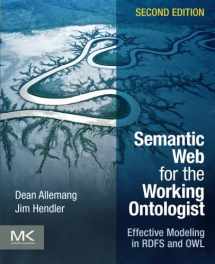
Semantic Web for the Working Ontologist: Effective Modeling in RDFS and OWL
ISBN-13:
9780123859655
ISBN-10:
0123859654
Edition:
2
Author:
James Hendler, Dean Allemang
Publication date:
2011
Publisher:
Morgan Kaufmann
Format:
Paperback
384 pages
Category:
Business Technology
,
Microsoft Programming
,
Programming
,
Web Design
,
Web Development & Design
,
XML
,
Programming Languages
FREE US shipping
Book details
ISBN-13:
9780123859655
ISBN-10:
0123859654
Edition:
2
Author:
James Hendler, Dean Allemang
Publication date:
2011
Publisher:
Morgan Kaufmann
Format:
Paperback
384 pages
Category:
Business Technology
,
Microsoft Programming
,
Programming
,
Web Design
,
Web Development & Design
,
XML
,
Programming Languages
Summary
Semantic Web for the Working Ontologist: Effective Modeling in RDFS and OWL (ISBN-13: 9780123859655 and ISBN-10: 0123859654), written by authors
James Hendler, Dean Allemang, was published by Morgan Kaufmann in 2011.
With an overall rating of 4.5 stars, it's a notable title among other
Business Technology
(Microsoft Programming, Programming, Web Design, Web Development & Design, XML, Programming Languages) books. You can easily purchase or rent Semantic Web for the Working Ontologist: Effective Modeling in RDFS and OWL (Paperback) from BooksRun,
along with many other new and used
Business Technology
books
and textbooks.
And, if you're looking to sell your copy, our current buyback offer is $0.32.
Description
Semantic Web for the Working Ontologist: Effective Modeling in RDFS and OWL, Second Edition, discusses the capabilities of Semantic Web modeling languages, such as RDFS (Resource Description Framework Schema) and OWL (Web Ontology Language). Organized into 16 chapters, the book provides examples to illustrate the use of Semantic Web technologies in solving common modeling problems. It uses the life and works of William Shakespeare to demonstrate some of the most basic capabilities of the Semantic Web. The book first provides an overview of the Semantic Web and aspects of the Web. It then discusses semantic modeling and how it can support the development from chaotic information gathering to one characterized by information sharing, cooperation, and collaboration. It also explains the use of RDF to implement the Semantic Web by allowing information to be distributed over the Web, along with the use of SPARQL to access RDF data. Moreover, the reader is introduced to components that make up a Semantic Web deployment and how they fit together, the concept of inferencing in the Semantic Web, and how RDFS differs from other schema languages. Finally, the book considers the use of SKOS (Simple Knowledge Organization System) to manage vocabularies by taking advantage of the inferencing structure of RDFS-Plus. This book is intended for the working ontologist who is trying to create a domain model on the Semantic Web.


We would LOVE it if you could help us and other readers by reviewing the book
Book review

Congratulations! We have received your book review.
{user}
{createdAt}
by {truncated_author}




